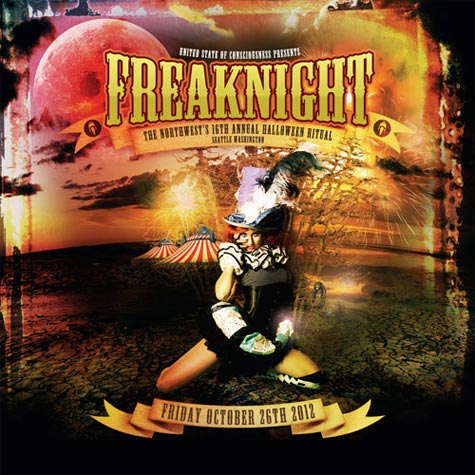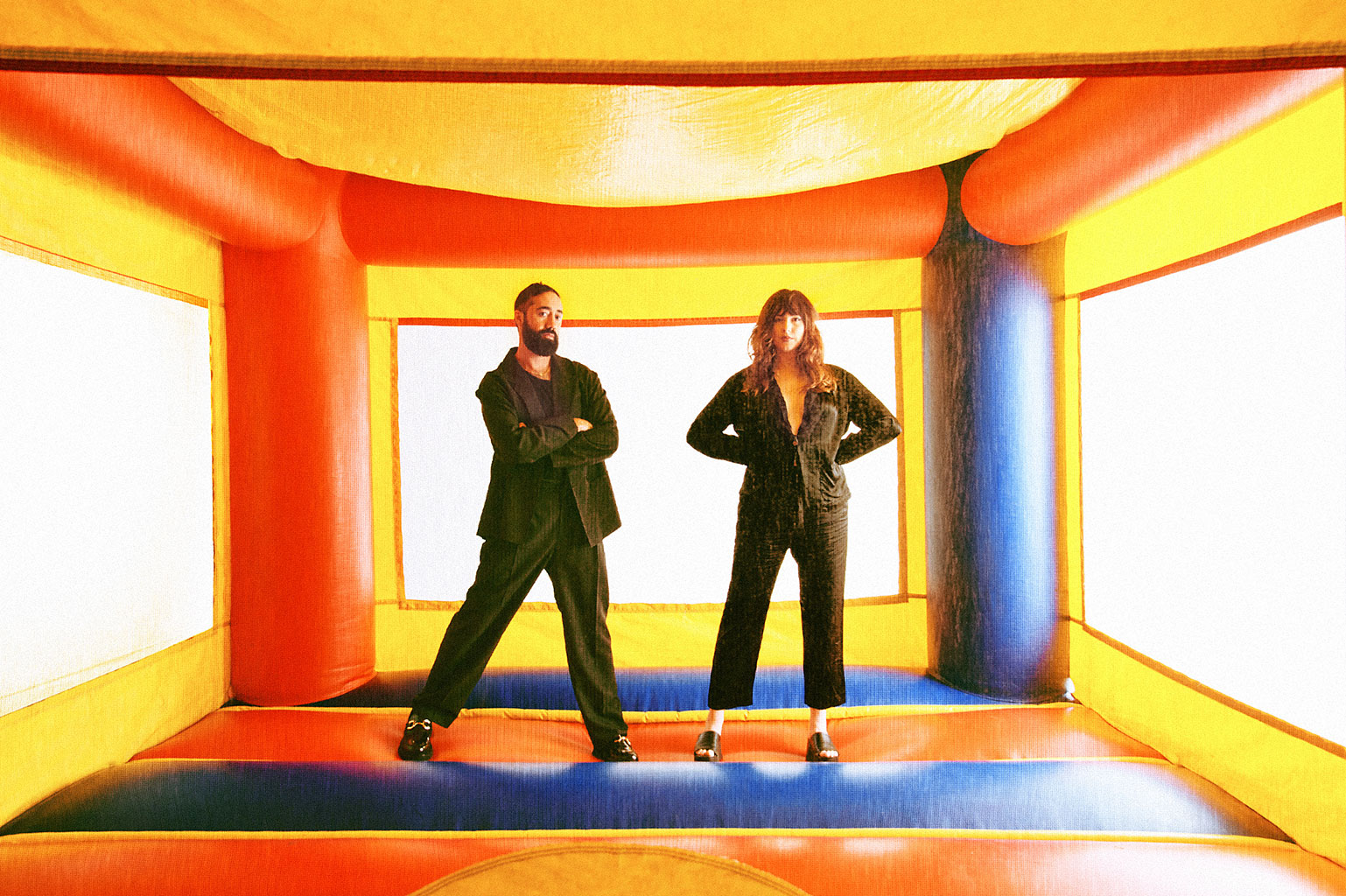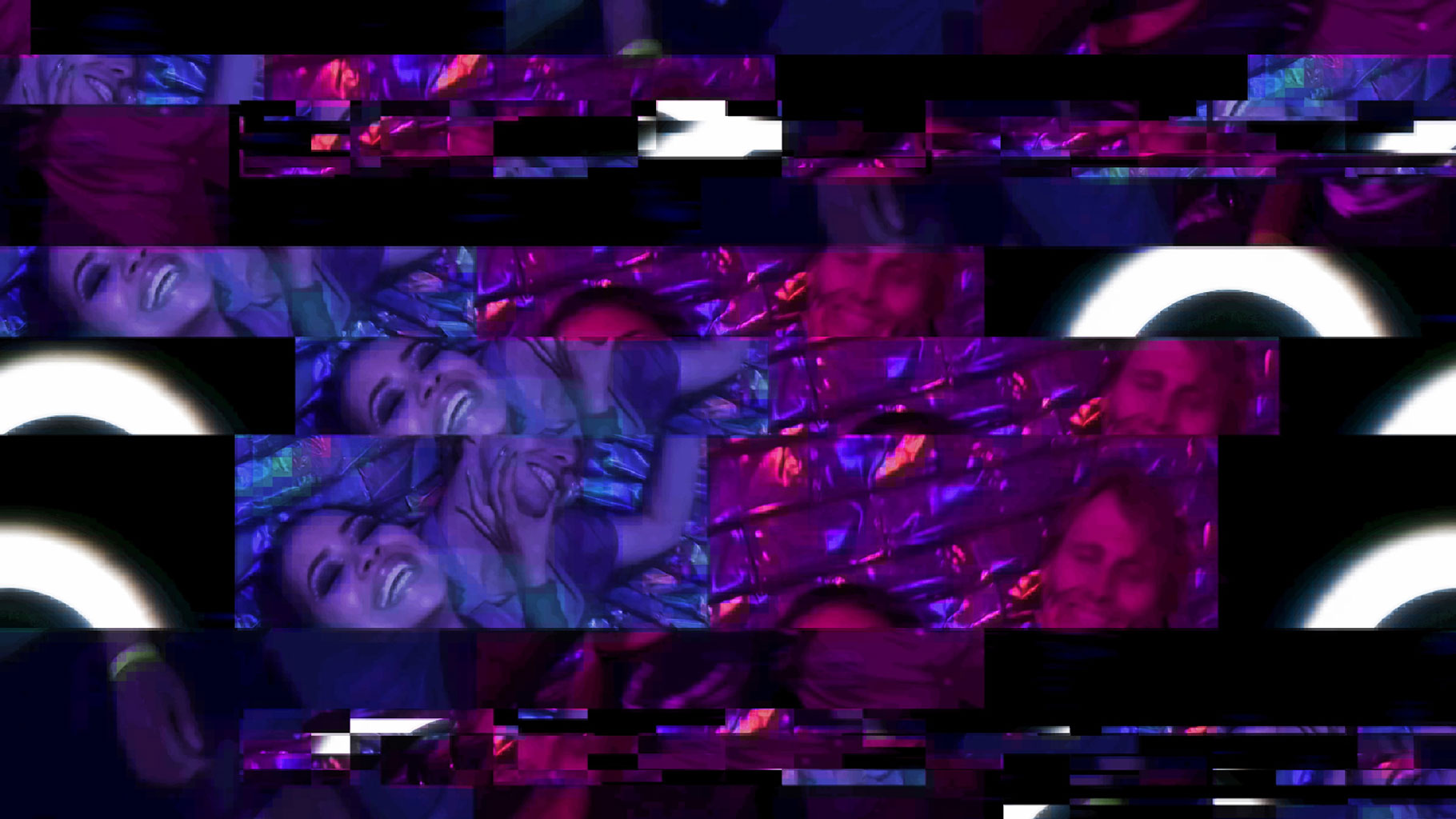 2012 marked the 16th anniversary of United States of Consciousness (USC)’s annual Halloween party, Freak Night. One of Seattle’s premiere electronic music massives, Freak Night has seen multiple venue changes through the years, beginning in spaces like indoor soccer fields (1998)1 and floating to and from miscellaneous warehouse and events spaces like Fremont Studios (2006)2. Yet these days, it always seems to end up back at its most high-profile venue, WaMu Theatre in Seattle’s SoDo neighborhood. WaMu Theater, formerly known as the Exhibition Hall, houses Freak Night’s multiple rooms comfortably, with a layout and configuration that seems to change from year to year as the event grows and shrinks accordingly to industry flux. And now, with electronic dance music (EDM) bigger than ever, Freak Night has followed suit, with 2012 housing the largest population for the festival to date.
2012 marked the 16th anniversary of United States of Consciousness (USC)’s annual Halloween party, Freak Night. One of Seattle’s premiere electronic music massives, Freak Night has seen multiple venue changes through the years, beginning in spaces like indoor soccer fields (1998)1 and floating to and from miscellaneous warehouse and events spaces like Fremont Studios (2006)2. Yet these days, it always seems to end up back at its most high-profile venue, WaMu Theatre in Seattle’s SoDo neighborhood. WaMu Theater, formerly known as the Exhibition Hall, houses Freak Night’s multiple rooms comfortably, with a layout and configuration that seems to change from year to year as the event grows and shrinks accordingly to industry flux. And now, with electronic dance music (EDM) bigger than ever, Freak Night has followed suit, with 2012 housing the largest population for the festival to date.
By the time I arrived at WaMu Theater, it was 11:00pm and I was quite surprised to see a rather large line outside the venue. Due to needing to pick up my press pass and hop in quickly at a nearby art show, I managed to avoid the line completely, but heard through text messages from friends that the line was completely not moving, despite the fact that the doors has supposedly opened at 7:00pm. No one knew what was happening and the only rumor I heard was that someone had been caught with narcotics for sale. When I returned an hour later after popping by a nearby art show, the line had disappeared and everyone was hurriedly ushered into the venue with brisk ID checking and the most laughable patdowns imaginable. USC events are usually fairly stringent with their security so this was a surprise; I can only imagine the effort was sped up in an attempt to please partygoers. (Unfortunately, though USC later issued an apology3, many people let their disatisfaction get the best of them and let that circumstance color their entire experience.)
The changes have been great, most notably in size and in visual displays. It is now standard that every stage has live visuals via video artists using Max MSP and light displays that add character to each individual DJ’s personality. A decade to half a decade ago, an event like Freak Night that boasted three rooms of electronic music would have had a fairly stock selection with one room of house, one room of trance, and one room of drum n’ bass and/or breaks. These days, thanks to the merging of all genres, the drum n’ bass and breaks room has been primarily replaced by dubstep, with house and trance switching intermittently on the Twisted Big Top Main Stage and Super You&Me mid-size stage.
Chuckie
I spent a decent amount of time at the Twisted Big Top, and can say with extreme clarity that Chuckie is one of the most obnoxious DJs I have ever seen. The man seemed completely unable to control himself, constantly interrupting his own set with vapid commentary and messy transitions. Luckily, it only went up from there on the Main Stage, with Sander Van Doorn clearly a better DJ and the legendary Armin Van Buuren predictably better still.
My main interest, however, lied at the smallest room of the three, the Cauldron of Bass. I have some of the best moments of my life getting self-actualized dancing in dark, dingy, and camo-netted drum n’ bass side rooms, so it was disappointing that a Cauldron of Bass this evening seemed not to include much drum n’ bass. Yet this was something I had predicted from a start, knowing that dubstep is the new drum n’ bass replacement. What I had not expected was that despite how much mainstream attention dubstep has received and how overblown its reputation is — both in the positive and negtive — it is still, in situations like larger electronic music festivals, generally a red-headed stepchild, though there are occsasional exceptions.
When one considers the reputation that dubstep now has in the United States, one can’t help but be annoyed that it has been usurped by frat boys and dirty clubs or is used by out-of-touch companies trying to come off as “in the know”. But the truth of the matter is that despite the fact that dubstep has gotten mainstream attention through musicians like Rusko and Skrillex, it remains in the smallest room — and it probably will never have the Main Stage appeal that more palatable genres of electronica will. And therein lies the beauty of dubstep in such a live setting; for even if you are an individual who absolutely hates dubstep’s current reputation, it’s still the underdog in a lot of ways. Once you spend a half hour in the dubstep room, you’ll realize that, like an extension of the genres formerly represented by the same side room, it is here that you will still find the most experimental dance moves and arguably the most diverse cross-section of individuals.
Borgore
Playing the 1:00am to 2:00am slot in the Cauldron of Bass room was Israeli artist Borgore, also known as Asaf Borger. The mid-’20s DJ has once been quoted in an AOL Spinner interview as saying, “My music sounds like commercial American hip-hop and death metal being played through various farm animals,” and this description certainly held true this evening. Borgore lives up to the “gore” in his name by incorporating sound clips both primal and base.
Love it or hate it, when dubstep is represented by a talented musician, there is a charm and an art to it that blends genres and percussive genres with fascination. Its close relation to drum n’ bass, breaks, and hip-hop are why it attracts a more urban demographic much of the time, and a dubstep beat, when qualified by its rhythms alone, can be more reminiscent of a hardcore breakdown than other types of electronica. Its brutal nature also holds the same vibe as harder styles of rock music, so it’s no wonder that Borgore kept hilariously telling the crowd to form a mosh pit in the center of the room. Though I can’t tell if that act was successful and though I could have cared less for his telling women to get on stage and take off their tops (which they did not do) Borgore certainly performed an extremely entertaining set and brought a lot of his personality into the mix, even if that personality was “humorously” vile. Even when power cut out twice onstage and he had to stop playing completely, he seemed to handle the matter lightheartedly.
Caspa
London-based dubstep producer Caspa aka Gary McCann closed out the Super You&Me stage. The well-reputed producer has tons of releases and remixes under his belt, and his set just barely overlapped with that of main headliner Armin Van Buuren. The Super You&Me stage generally played more hard house, techno, and atonal dance music than the main stage, but even here dubstep was the red-headed stepchild of the night. As Caspa’s set progressed, the room began to empty out — but not for his lack of collage-work talent.
Seeing Freak Night grow through the years has been a fascinating exercise. USC began their concert-throwing days in 1996, with a “vision for an electronic dance music experience that went beyond your typical concert.” Despite the snafus that come inherent in any production company’s expansion, USC’s presentation in 2012 with indoor carnival rides and their high-tech use of audio-visual equipment spoke volumes about the ways they’re working to grow Freak Night. I trust that they’re doing the best they can, and old-school me is quite excited that they’ll have drum n’ bass heavyweight Dieselboy at their upcoming New Year’s party, Resolution.
I do have some critiques I would like to extend, though, particularly one which seems especially obvious to one who has grown apart from this scene. The electronic music industry is changing, and the divisions between electronic and indie electronic or DJs and live musicians are totally ridiculous. Groups like USC are in a unique position to help dissolve them, and they should. Take some cues from Seattle’s reputable electronic music event, Decibel Festival, and take some risks in bringing in less traditional electronic musicians and those who are using more cutting-edge and performance-based technologies. You’ve done it before with bands like Deepsky; do it again. (And, in terms of Freak Night in particular, the rides are great, but bring back the psychic and palm readings and the massage tables, please.)
Sources
1 Save The Rave. Seattle Times, 1999 December 1.
2 -=FREAKNIGHT X=-, ClubVibes.
3 FreakNight 2012 Line Situation. Facebook, 2012 October 29.
4 Unconscious Promotion. The Stranger, 2001 June.














I really like your blog.. very nice colors & theme. Did you make this website yourself or did you hire someone to do it for you? Plz respond as I’m looking to construct my own blog and would like to know where u got this from. thank you cecegefgddfb